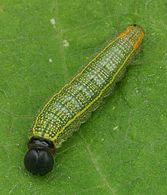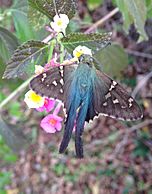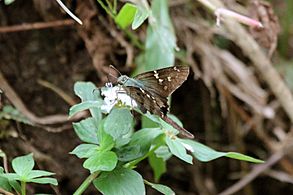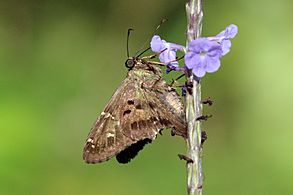Long-tailed skipper facts for kids
Quick facts for kids Long-tailed skipper |
|
|---|---|
 |
|
| Conservation status | |
| Scientific classification | |
| Kingdom: | |
| Phylum: | |
| Class: | |
| Order: | |
| Family: | |
| Genus: | |
| Species: |
U. proteus
|
| Binomial name | |
| Urbanus proteus (Linnaeus, 1758)
|
|
The long-tailed skipper (Urbanus proteus) is a type of skipper butterfly. You can find it in warm, tropical, and subtropical parts of South America, reaching as far south as Argentina. It also lives north into the southern United States. This butterfly cannot survive in places that have long periods of freezing weather.
It is a very noticeable butterfly. Its wings are light brown with a shiny, iridescent blue tint. It also has two long tails that stick out from its back wings. The main part of its body is strong and light blue on top. This butterfly has a large head and big, noticeable eyes. Its wingspan, which is the distance from one wingtip to the other, is usually between 4.5 and 6 centimeters.
Life cycle
The long-tailed skipper starts its life by laying white or yellow eggs. These eggs are laid one by one or in small groups. From these eggs, a caterpillar hatches. This caterpillar has a yellowish body and a large, dark head.
After about two to three weeks, the caterpillar changes into a pupa. The pupa is usually found inside a rolled-up leaf. It is covered with fine, bluish hairs. The pupa stage can last anywhere from one to three weeks. After this time, the adult butterfly comes out.
The caterpillar of this butterfly is sometimes a problem for farmers. It often eats crops, especially beans, in the southern United States. Because of this, it is sometimes called the bean leafroller in those areas. These caterpillars also like to eat ornamental plants from the legume family. Examples include wisteria and butterfly peas.
The caterpillars feed on leaves. Then, they roll the leaves around themselves and line the inside with silk. This is where they form their pupa. Adult long-tailed skippers drink nectar from flowers.
Some animals are natural enemies of this butterfly. These include certain types of wasps and flies that are parasitoids. The Florida predatory stink bug (Euthyrhynchus floridanus) also preys on them. In the fall, a special virus called a nuclear polyhedrosis virus has been known to kill up to half of the young caterpillars.
Sub-species
One type of long-tailed skipper is called U. p. domingo. This sub-species lives in the Bahamas and throughout the West Indies. It is very similar to the main type of long-tailed skipper. The main difference is that its white markings are not as strong.
-
U. p. domingo, Jamaica
-
U. p. domingo, Grand Cayman
- Butterflies of Houston and Southeast Texas, by John & Gloria Tveten
See also
 In Spanish: Urbanus proteus para niños
In Spanish: Urbanus proteus para niños







